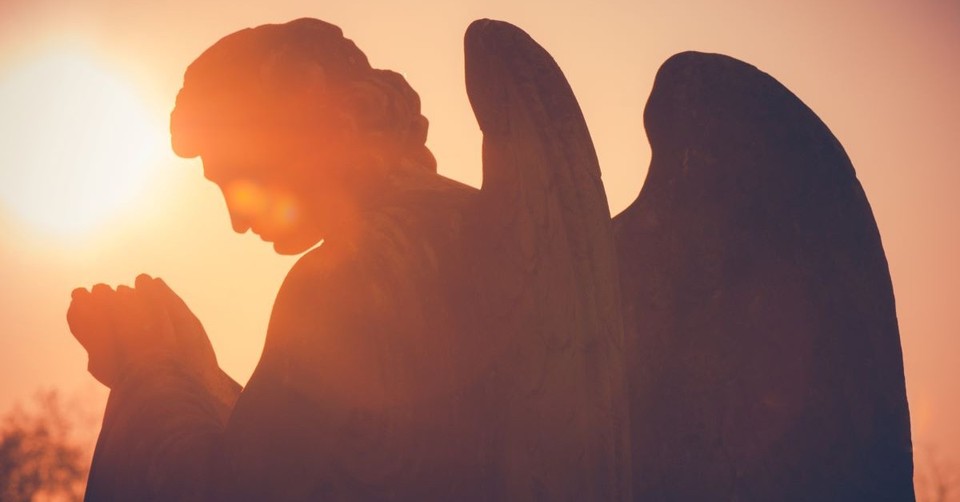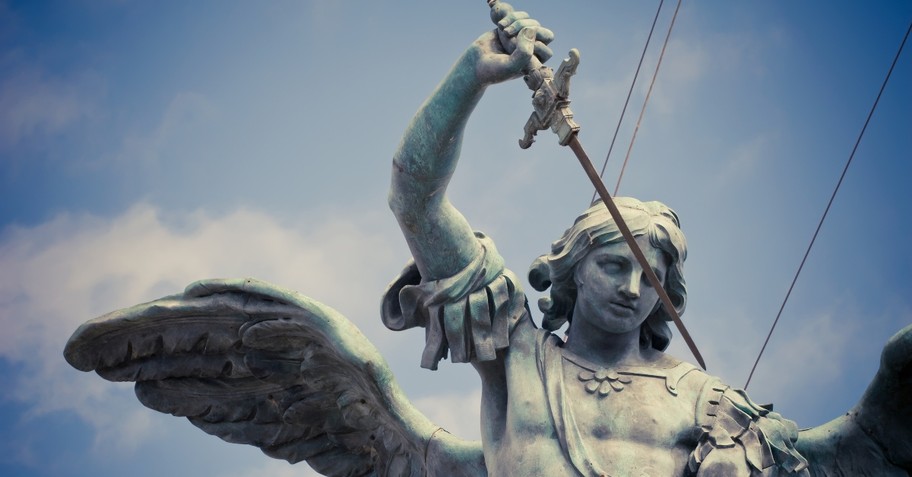Is There an Angel Hierarchy?

Angels have remained an integral part of art, culture, and religion for all of human existence. As a culture, we believe in the theory that angels comfort, warn, and protect us.
How many of those ideas are true? How much power do angels actually have over our lives? Do angels exist in an angel hierarchy? Can angels help me when I’m in trouble? These are all good questions with answers embedded in Scripture.
In hundreds of verses from Genesis to Revelation, the Bible presents angels and their influence over the spiritual and physical world. Jesus himself mentions angels and receives the ministry of angels while he is the Son of Man.
So, here’s what is not true. No Bible verses suggest that angels are the ghosts of people nor are they chubby babies with wings. Instead, Scripture presents consistent characteristics of angels, many of which point to a hierarchy of angelic authority that’s critical to our understanding of God’s purpose and protection over our lives. Jude 9 mentions Michael as God’s archangel, which shows his authority over other angels. In Revelation 12, Michael acts as commander of the angel army. Michael’s leadership position suggests a hierarchy of angels in the heavenly realms.
Photo Credit: ©GettyImages/umbertoleporini

Angel Hierarchy
The theology of angels varies between individuals and denominations. In the fifth century, Christian philosopher Pseudo-Dionysius divided angels into 3 hierarchies with 9 orders, listing seraphim as the highest order and angels like Gabriel as the lowest. Only a few of Pseudo-Dionysius’ orders directly correspond to Scriptural proofs, but his observations about angels’ activity overlap with other listings of angels. He claimed angels can be divided into the following categories: seraphim, cherubim, thrones, dominions, virtues, powers, principalities, archangels, and angels.
His categories of angels as dominions, virtues, powers, or principalities are rooted in Ephesians 6:12, which is a verse about spiritual warfare in the heavenly realms. However, these words in the Greek refer to general governing authorities, not to specific categories of angels.
However, the context of the Ephesians passage does use these terms to speak to the hierarchy of demons—principalities, powers, rulers of darkness, and spiritual forces of evil—are the spirit beings that we should be doing warfare against through the mighty power of God (Ephesians 6:10-12). These verses set up the argument for the famous armor of God passage that follows (verses 13-18). The war being waged in the spirit world is precisely the reason we need armor, prayer, and the Holy Spirit’s power.
Perhaps a more provable angel hierarchy is supported by modern theologians (Dr. Charles Ryrie uses a similar list) who place the archangels at the top (Michael and possibly Gabriel), followed by other categories of angels. Sometimes, angels are divided into these groups: archangels, chief princes, ruling angels, guardian angels, seraphim, cherubim, elect angels, and living creatures, which are all terms used in Scripture. Note the following Scriptural references and determiners for each:
-Archangels—authoritative representatives for God; the Bible refers to archangels (plural), but only gives Michael’s name in connection to this term, as well as “chief prince.” (Jude 9, Revelation 12:7-8, 1 Thessalonians 4:16.). The angel Gabriel (Daniel 8:16, Daniel 9:20-21, Luke 1:19-27) is not given a title in Scripture, but many theologians consider him to be an archangel as well, since he and Michael are the only named angels in Scripture, besides Lucifer. Daniel 10 references the existence of more than “one of the chief princes.” Gabriel is certainly the most important angel messenger. He lists his credentials while appearing to Zechariah in Luke 1 by saying, “I am Gabriel. I stand in the presence of God. I have been sent to speak to you.” He also appears to Daniel and Mary. Lucifer (“light-giver” or “morning star”) is the angel who goes by “Satan” (“deceiver”) after his fall from heaven. He may have also been an archangel, given his name and influence in heaven.
-Chief princes—have authority and influence over earthly principalities and dominions (Daniel 10:13). Daniel 10 is a provocative look at angel hierarchy and duties. The messenger could not reach Daniel without the help of Michael. Perhaps chief princes are also archangels, or perhaps they are a sub-category of angels in leadership.
-Ruling angels—authoritative in the heavenly realm (Ephesians 3:10)
-Guardian angels—protect people, including children (Hebrews 1:14, Matthew 18:10, Psalm 91:11-12, Acts 12:15)
-Seraphim—designated to continually worship the Lord in heaven (Isaiah 6:1-3)
-Cherubim—guard the holiness of God, in heaven and on earth (Genesis 3:22-24, Ezekiel 10:1-22, Psalm 18:10, Exodus 25:18-22)
-Elect angels—with Jesus, they watch over earthly leaders (1 Timothy 5:21)
-Living creatures—celestial creatures who surround God (Ezekiel 1:5-14, Revelation 4:6-8)
Considering an angel hierarchy can broaden our understanding of the breadth of God’s love for mankind and the structure he has put in place to protect and communicate with us. An angel hierarchy provides a structure for understanding the complexities of the spirit world. It shows us the importance God places on spiritual warfare and the protection of the saints.
Daniel 9 and 10 contain a few sections where we can see the role of angels and the actual spiritual battle they are waging against Satan’s host of demons. While Revelation is apocryphal, the book of Daniel is a mixture of historical events and prophetic dreams. In Daniel 9, Gabriel comes to Daniel “in swift flight” while he is fasting and praying to deliver a prophetic message. In the next chapter, Daniel is visited by a different angel after another three weeks of fasting and prayer. The angel declares that when Daniel began to humble himself in prayer, the angel tried to bring him an answer. Yet for 21 days, the demon in charge of the Persian King Cyrus (demons also have a hierarchy) fought to keep the angel from reaching Daniel. Michael arrives to fight with this angel against the demon assigned to Cyrus. Together, Michael and the angel break off the evil spirit’s power, and the angel delivers the Lord’s prophecy to Daniel, who writes it down for God’s people to read. This passage reveals that angels and demons are assigned to humans—demons are assigned to deceive, injure, and kill, while angels are assigned to direct, protect, and wage war over their human charges.
Photo Credit: ©Getty Images/MoosyElk
Characteristics of Angels
Angels are beautiful and terrifying creatures. When they appear in their heavenly form, they must tell their human audience not to be afraid. They are obedient and loyal to God as their authority. They make clear that their message comes from God himself—they are agents of obedience and worship.
Scripture’s recording of angelic activity involves protection, calling, warning, and warfare. In fact, the angels’ submission to God stands as an example for believers to emulate (Matthew 6:10, Revelation 5:11-12). Angels apparently have had a choice to follow God, since a third of them left heaven with Lucifer when he staged a coup against God (Ezekiel 28:11-15, Isaiah 14:12-20).
Angels have intellect (1 Peter 1:12), emotion (Luke 2:13), and will (Jude 6). They are created beings (Colossians 1:16, Nehemiah 9:6, Genesis 2:1, Exodus 20:11), made before the world’s creation was complete (Job 38:6-7). They have specific tasks and responsibilities. These differing characteristics have guided experts toward the opinion that angels fall into a hierarchal structure. Their general characteristics include:
-Traveling in flight (Daniel 10:12-14)
-Spiritual beings (Hebrews 1:13-14, Luke 24:39)
-Unmarried--Scripture refers to them in the masculine form (Mark 12:25, Genesis 18:1-2, Zechariah 5:9, Matthew 22:30, Luke 20:34-36). Their reproductivity on earth is questioned by some scholars, as the “sons of God went to the daughters of humans and had children by them” in Genesis 6:9. Some believe this verse refers to angels who intermarried with humans and created “demi-gods.” But there is no marriage in heaven for anyone, angels or humans.
-Eternal (Luke 20:36)
-Powerful (Matthew 28:2, 2 Peter 2:11, Colossians 1:16, Psalm 103:20, Ephesians 1:21, Daniel 10:13, Revelation 12:7-8 & 20:1-5)
-Innumerable (Hebrews 12:22, Deuteronomy 33:2, Psalm 68:17, Revelation 5:11)
-Invisible unless revealed (Numbers 22:31, 2 Kings 6:17, Luke 2:13)
-Can take on the appearance of a human (Genesis 18, Daniel 8:15)
Duties of Angels
Angels accomplish the following tasks in their unwavering service to the Lord:
-Announce, support, and protect Jesus (Luke 1:26-32, Luke 2:13, Matthew 2:13, Matthew 4:11, Matthew 26:53, Luke 22:41, Matthew 28:2, Matthew 28:6)
-Assist and protect humans (Hebrews 1:14, Acts 12:7, 1 Corinthians 4:9, 1 Timothy 5:21, Luke 15:10, Acts 8:26, Luke 16:22, Jude 9)
-Announcements—speak both blessing and cursing (Luke 1, Matthew 1, Daniel 11)
-Fight demons, wage spiritual warfare (Ephesians 6, Revelation 14, Acts 12)
-Assist in punishing God’s enemies (2 Samuel 24:16-17, 2 Chronicles 32:21, Acts 12:23, Revelation 16:1, Matthew 13:39, Revelation 8, 9 & 16))
The Angel of the Lord
Many places in Scripture the term “the angel of the Lord” appears. This is not the same phrase as “an angel of the Lord.” Most theologians believe that THE angel of the Lord refers to Jesus Christ himself—the preincarnate Christ. In the Old Testament, Jesus appears to many individuals (Hagar, Abraham, Moses, Balaam, the Israelites, Gideon, Manoah and his wife, David, and Elijah) with authoritative calling. The Angel of the Lord always speaks as God himself. This communication differs from the way other angels deliver messages (FROM the Lord). In those cases, the messenger angels begin their declarations or instructions with a phrase like “The Lord says,” demonstrating that the angels themselves are merely carriers of truth rather than Truth Incarnate.
Another indicator that “the angel of the Lord” is God himself is to notice how receivers respond to the angelic messages. In 2 Samuel 24, an angel stretches out his hand to destroy Jerusalem for its sin, but David intercedes for the people and takes the blame. In verse 17, David addresses the angel, but the text says that David “said to THE LORD…” Then David asks for God’s “hand to fall upon me and my family.” David knows that this angel is the Lord himself.
Many other encounters with the Preincarnate Christ exist in the Old Testament. Both Moses and Joshua meet the Angel of the Lord, who tells them to take off their shoes because they’re standing on holy ground. In Genesis 18, three men arrive at Abraham’s tent to warn him about the destruction of Sodom and Gomorrah, where Abraham’s nephew Lot lives. Suddenly, one of the men is called “THE LORD.” The other two men, called “angels” in chapter 19, leave for Sodom, but the Lord stays behind to talk with Abraham. Clearly, this being has the authority change his mind about destroying Sodom; the other two angels operate under God’s authority in the next chapter. The angels have power and authority, but they operate under the authority of the Angel of the Lord.

Angels in Your Everyday Life
Angel appearances in Scripture show that while some angels appear shining and terrifying, other angels are mistaken for people.
The Bible contains many stories of angel appearances. Abraham promises his servant that an angel will accompany him on his journey to find Isaac a wife (Genesis 24). An angel stops Balaam in the middle of a path while he rides a donkey to deliver a curse on his enemy. Angels minister to Jesus in Gethsemane before his crucifixion. An angel appears to Peter in prison and breaks him out. An angel sends Philip to witness to the Ethiopian eunuch. An angel appears to Peter in a dream, revealing that salvation will be offered to the Gentiles. An angel affirms Cornelius’ prayers to receive the gospel message. An angel encourages Paul that his calling will take him to stand on trial in Rome for his faith. Angels are messengers of hope and calling to normal people engaged in seeking God.
Even today, angel stories are prevalent in literature and personal testimony. During a traumatic situation, some people testify to the appearance of angels who give them support, help, or protection. Based on Scripture, it seems logical that such appearances are still possible today.
The author of Hebrews tells believers, “Do not forget to show hospitality to strangers, for by so doing, some people have shown hospitality to angels without knowing it.” (Hebrews 13:2).
Angels can protect, help, defend, and call any of us into living more powerful and effective lives for Christ.
Photo Credit: Austin Kehmeier/Unsplash
Originally published January 25, 2022.









